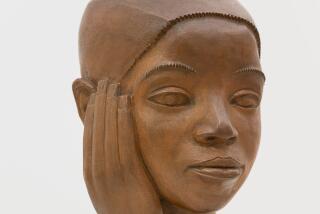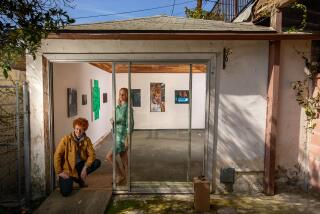For Black Artists, a New Champion
- Share via
Paintings, sculpture and works on paper from the 1930s and ‘40s; posters from the late 19th and early 20th centuries; California photography and ephemera from 1860 to 1960. Los Angeles art dealer Steve Turner has developed quite a list of specialties since he opened his first gallery in 1988. But in recent years he has turned his attention to yet another category--African American art--and it is consuming more and more of his time, energy and exhibition space.
“Not Just February: Works by African American Artists, 1817-2002,” a concise survey of works by 20 artists--pointedly not staged during Black History Month--opens Friday at his small, second-floor gallery on South Beverly Drive in Beverly Hills. The centerpiece of an African American series, it follows a show of works by Los Angeles artists Mark Greenfield and Talita Long, and precedes an exhibition featuring the work of Merton Simpson and Herbert Gentry, who divide their time between New York and Europe.
Along with his burgeoning exhibition program, Turner has established a foundation to provide financial aid for young African American artists. Each year, the William H. Johnson Foundation for the Arts will give a grant in honor of Johnson, an accomplished but largely forgotten painter who died in 1970. The first grant, to be awarded at the end of this year, will be $15,000. Subsequent grants, made after the foundation has raised more funds, will be $25,000.
The impetus for all this activity was “William H. Johnson: Truth Be Told,” a traveling exhibition that Turner organized and presented at his gallery two years ago. That show, in turn, was the result of an exhaustive research project, documented in a book written by Turner and his wife, Victoria Dailey. The story they tell is a mixture of joy and tragedy, recognition and neglect, with a tragic ending.
Born in South Carolina in 1901, Johnson studied art at New York’s National Academy of Design and, with the help of a professor and friends, continued his education in France. He married Danish artist Holcha Krake and settled in Denmark, but traveled widely and returned to New York during World War II.
Krake died of cancer in 1944 and Johnson, finding little interest in his work in New York, returned to Denmark in 1946. On a trip to Norway the following year, he was diagnosed with a degenerative brain disease caused by syphilis. He was hospitalized in Norway, then sent by ship to the United States. He never painted again and spent his last 23 years at Central Islip State Hospital on Long Island.
Johnson left a body of work that encompasses folkloric portrayals of black people, and expressionistic landscapes, still-lifes and portraits. But while looking for his paintings and piecing together details of his life, Turner came to believe that Johnson’s estate was mishandled. His work should have been sent to his relatives in Denmark after his death, but it was taken over by a foundation that did little to promote or protect it, Turner contends. His documentation lists more than 50 pieces in the estate that have gone to private collections or to market, have been moved from one institution to another, or have simply been lost.
Turner wasn’t able to answer all his questions about Johnson’s work, but “the project gave me a great sense of accomplishment,” he says. “And in doing it, I encountered a lot of African American artists, collectors and curators who said I should do more work in this area. I already had a great library on the artists, so I started to think about who I could show in Los Angeles.”
As Turner looked into the subject, he realized how little visibility African American artists have had in local museums and galleries. “There hasn’t been widespread support here,” he says. “There are a few collectors and a few people who sell work by one African American artist or another, but there isn’t the kind of activity that exists in cities like Detroit or Charlotte, North Carolina.”
Greenfield, who directs the Watts Towers Arts Center while pursuing his career as an artist, says he felt “a little bit of reticence” when he first heard about Turner’s African American projects. “It was a white person doing it,” he says, “but I don’t care at this point. What he’s got in mind is something that needs to happen. I don’t care who does it, as long as it gets done.”
Turner’s first African American show following the Johnson project featured the paintings of Richard Mayhew, who retired in Santa Cruz after a long teaching career at Penn State and other universities. “He has been showing since the ‘50s and sells his work in New York, Detroit and San Francisco. He is very good at getting his work out,” says Turner, who essentially introduced the artist to Los Angeles last year and sold a few of Mayhew’s works to his clientele.
Continuing to plot his course, Turner noticed that mid-career artists generally have more difficulty getting their work shown than those who are more or less established. “If you are Richard Mayhew--if you are almost 80 and you have been a devoted artist throughout your life--there is interest in you,” he says. “And emerging artists of any sort, including African Americans, are starting to get attention.
“I have always been a contrarian. I choose difficult things, so instead of just showing the 80-year-olds or looking for emerging artists, I decided to show two mid-career artists, Mark Greenfield and Talita Long, whose work has been in community galleries but who haven’t had much contact with collectors. There is nothing like that to give them a sense of what people think of them, and it fuels them to do more work.”
After the Mayhew show, his next African American exhibition was “History & Mystery,” a selection of Greenfield’s assemblages based on old photographs of blackface entertainers, and Long’s figurative monotypes.
Even as that show was in the works, Turner was organizing the current historical survey, making it small enough to fit into his gallery but varied enough to indicate the breadth of work by African Americans. “It’s not just one style,” he says. “Broad surveys of American art tend to include one African American artist. If it’s the 20th century, it’s Jacob Lawrence; if it’s the 19th century, it’s Henry Ossawa Tanner.”
Both artists are represented in “Not Just February,” but so are Joshua Johnson (circa 1765-1830), who lived in Baltimore and painted portraits of the white merchant class, and contemporary artists Benny Andrews, Michael Ray Charles, David Hammons, John Outterbridge and Howardena Pindell. With works ranging from watercolors and oil paintings to body prints and steel sculpture, they defy easy classification.
“I am trying to break down the expectation that the work will look a certain way,” Turner says. “It can be anything and ought to be anything.” It can also be shown anytime, he says. “The title, ‘Not Just February,’ came about because I wanted to send that message.”
In shaping his exhibition agenda, Turner decided to memorialize the artist who inspired him, William H. Johnson. “My idea for something to honor him appropriately and sort of bring my project full circle was to start a grant-giving foundation,” he says. “We plan to give grants to African Americans in the first third or first half of their careers, when they are around 25, 30 or 35 and on the edge of producing a body of work that can be exhibited and purchased. So many artists have brief careers because it’s exceedingly tough to have the freedom to create. We wanted the grants to be big enough so they can take some time off from their jobs.”
“I think the foundation is a great idea,” says Greenfield, who has agreed to serve on the selection committee along with Outterbridge, Phoebe Beasley and other artists yet to be named. “If Steve can set an example and more people do something like this, maybe more young African Americans will be encouraged to pursue art. Right now, they aren’t getting enough support.”
The first fund-raiser for the foundation was held last year; two others, at the Oakland Museum and at the home of a board member in Pasadena, are scheduled this spring, says Turner, who heads the foundation’s board but will not be involved in selecting grant recipients. Applications, currently being sought through art schools, universities and art journals, will be due Nov. 30.
Enthusiastic as he may be about launching the grant program, Turner says boosterism has nothing to do with it. “Finding artists whose work should be and could be in museums is very selective, serious work,” he says. “Barriers move around, but they are still there. Just look at who is, and isn’t, in the museums and galleries.”
*
“NOT JUST FEBRUARY: WORKS BY AFRICAN AMERICAN ARTISTS, 1817-2002,” Steve Turner Gallery, 275 S. Beverly Drive, Beverly Hills. Dates: Friday-May 11. Wednesdays-Fridays, 11 a.m.-5 p.m.; Saturdays, 1-5 p.m. Admission: Free. Phone: (310) 271-3721.
*
Suzanne Muchnic is a Times staff writer.
More to Read
The biggest entertainment stories
Get our big stories about Hollywood, film, television, music, arts, culture and more right in your inbox as soon as they publish.
You may occasionally receive promotional content from the Los Angeles Times.










